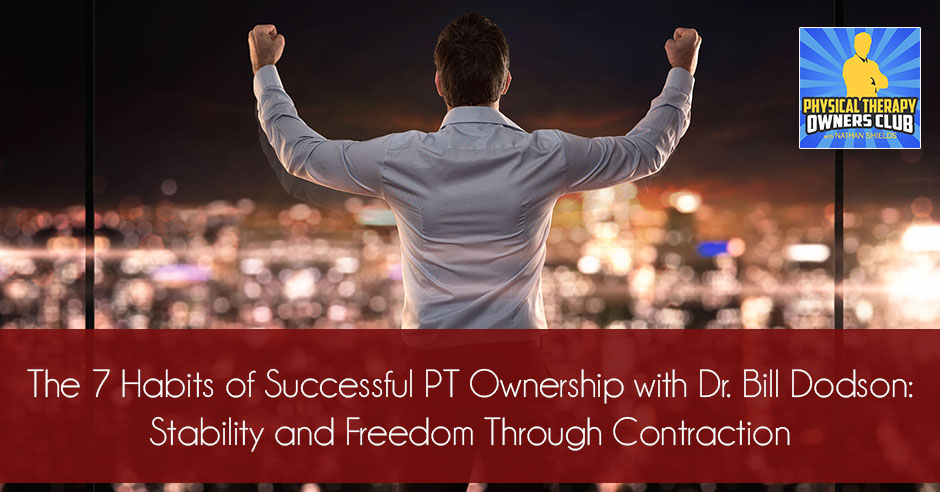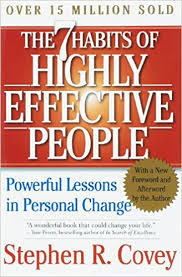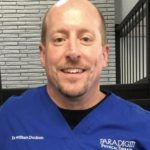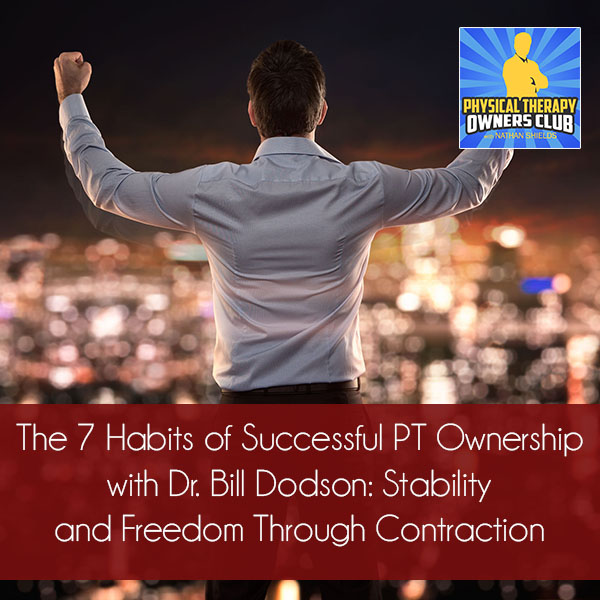
—
Listen to the podcast here:
The 7 Habits of Successful PT Ownership with Dr. Bill Dodson: Stability and Freedom Through Contraction

My guest is Dr. Bill Dodson of West Texas, specifically Midland-Odessa, Texas. I’m excited to bring you Dr. Bill Dodson onto the podcast because Bill has gone counter to everything we promote in the Physical Therapy Owner’s Club, and that is to grow and expand in order to obtain stability and freedom. Bill’s gone counter to that and has contracted and slowed things down in order to obtain that stability and freedom. One of the things that he’s also attributed his success to is the implementation of The 7 Habits of Highly Effective People into his life and practice. If you don’t know, The 7 Habits of Highly Effective People is a book written by Stephen Covey. It’s a fundamental self-help/business ownership book that you should read. Even if you haven’t read it, you’ve probably heard some of the concepts within it when you talk about paradigm shifts and putting first things first and beginning with the end in mind. A lot of those things come from Stephen Covey’s book.
Those seven habits specifically are, number one, be proactive. Number two, begin with the end in mind. Number three, put first things first. Four think win-win in any negotiation or relationship. Number five, seek first to understand then to be understood. Number six, synergize and leverage our differences for good. Number seven, sharpen the saw. Take time out of production to improve your skills. Other things that we also discussed a little bit in the podcast is Bill’s usage of the Covey Quadrant, which is the time management and task management system that Covey promotes. Even FDR alluded to such quadrant in his lifetime.
Nonetheless, to tell you a little bit about Bill, he has three clinics in Midland-Odessa and Monahans, Texas. After graduating from the University of Texas at Austin, he starts PT schooling at the University of Texas. He also got a Master’s of Science at Rocky Mountain University, followed by a Doctor of Science in 2007 and a Doctor of PT in 2008. He’s a board-certified OPT and a certified hand physical therapist. He’s been a PT clinic owner since 1993, a paradigm PT and sports wellness center. He’s been an adjunct professor at the University of Texas. He is the host of a weekly radio program on Saturday mornings called Bodytalk on AM 1070 KWEL. If you’re driving through West Texas or have access to that somehow, check him out.
Most notably, Bill has also developed a high-end EMR that is specific to physical therapy called Interactive Advanced Medicine. It’s a software program that he’s developed over a number of years and has been found to be very efficient. You can also find it at iAM-PT.com. Also to know, Bill is a Rotary Club member and a struggling guitarist of the past 40 years by his own admission. He also loves long walks on the beach, drinks by the poolside, candlelight dinners and long awkward hugs.
—
On the podcast, we have Bill Dodson, a physical therapist from Odessa, Texas. Bill is a friend of mine, through our interactions with hands-on diagnostics. I’ve always been intrigued with his story because he’s such a productive guy and he’s got a tremendous amount of experience in manual therapy. I wanted to have him on the podcast to learn from him and what makes him tick and honestly what makes him so productive. Bill, would you mind letting us know a little bit about your story? What got you into physical therapy, physical therapy ownership and what got you to where you are?
I’ve been a physical therapist for 27 years. Prior to that, I worked for a land development company. My brother and everybody else wanted me to be an accountant and do all this other stuff. He never felt like I was being led in a different direction. To be honest with it, I prayed really hard and let things happen the way they were supposed to be. It was a good thing. I went to the University of Texas medical branch in Galveston after I got my Biology degree at UT. Then I moved down here to West Texas. If people don’t know what West Texas is, it’s pretty big. I live in Midland, which is exactly halfway between Fort Worth and El Paso and that’s midland. Odessa is twenty miles west and Monahans is 34 miles west of that.
I moved here for one year and one year only. I was never going to stay here for one year longer because I wanted to visit my grandparents. My roots are from Midland. My grandma was born in Midland. Then all of a sudden, I worked at a hospital and I loved it. There were three things that I was never going to do when I was in PT school. First of all, I would never move to West Texas. Number two, I would never work in an outpatient clinic and number three, I was done with school. The first one, yes, I did move to West Texas and I said I was going stay one year and that was it.
Be Proactive. Begin with the end in mind. Put first things first........... (Steven Covey) Click To TweetNumber two, I would never work in an outpatient clinic. I wanted to stay a couple more years to hang out with my family. I hadn’t got to know my grandparents throughout my childhood. I valued their relationship because I never saw a good relationship with my family. It was important for me to pursue that, to view and to hopefully absorb some of the integrity that my grandparents had known with each other, but just in the community and stuff like that. I took a job at an outpatient clinic. The outpatient clinic, they were seeing twenty visits a week. Within three months they were up to 60 visits a week and twice that. We’re doing well. I had a good rapport with the doctors at the hospital and so they started sending me patients. Then I became a partner. They asked me to become a partner. I was thinking about going to medical school and God gave me a son, Lee. I decided that that was out of the question. I decided to be a partner at this clinic and then I bought him out and it was the Texas Institute of Sports Medicine, which is very difficult to say even to this day. That changed into something that is still just as difficult, Paradigm Physical Therapy.
Paradigm became a word for that I was trying to teach people around here. It was a new word back. Now, we all know what a paradigm is, it’s $0.20. As I was getting out on my own, there were a couple of physicians in Big Spring. They asked me to have a clinic there. There are a couple of physicians in Monahans and asked me to open a clinic there. The great thing about is that I had a pretty good reputation and not a reputation as a therapist, but as somebody who felt service. I’m not trying to pat myself on the back on that. I do believe in stewardship, I do believe in being a servant. Whether I was a bartender working at a TGI Friday’s or waiting tables or other places that I’ve worked in my life, I’ve always felt like I was a servant.
You feel a purpose. There are some people who may be their ideal scene is to have a physical therapy clinic at some point and be comfortable financially and professionally. You took it a step further. You saw what you were doing as a service to the community and the people that you’re with.
I felt like it. I love the community I live in. People will say, “It’s West Texas, what’s in West Texas?” The people out here, they bring you in and if you respect them and if you love them, and if you care about them, they’re there for you.
You eventually developed into how many clinics and where are you at?
I developed into four clinics. I had 55 employees and I had two hospital clinics, two hospitals in acute care. I also became a partner in that hospital. It was a great opportunity. When the doctors asked me to do it, I was the only non-physician that they asked to be a partner. They wanted me to do the therapy in the hospital because they knew that I was going to do a good job. I would work on Saturdays and Sundays and we clean beds. The thing is even though you have a DPT or DSAT, which DSAT when I came out of the university. I was still doing things that were service and servant-oriented. When you go to the acute care and then go acute care outpatient, typically we’ll see those patients and outpatient as well. The continuity of care became top notch. I finished my dissertation at Rocky Mountain and that was ten years ago. I’m going to tell you, I was wiped out.
Mentally, physically or energy?
Everything, spiritually. I felt like I was null and void. I felt like I would continue to take these punches at work every single day. You have 55 employees, you finish the hardest thing you’ve ever done in your entire life. You’re taking these punches and I said, “It’s time for me to revamp.” Maybe we’ll address some of the things that I’m doing because I will kill myself. I went eight years without a day off. I’m not joking. On weekends, I was working in the hospitals because none of my staff wanted to work on the weekends. If I was in town, I was working. Usually, when I

left town it was either for family stuff that needed to be fixed or going off for schooling or education. I needed to adjust things. I made a plan to evolve as a person and de-evolve as a business. I started looking at some things and I’m not saying de-evolve as a business. It’s basically shrinking.
You’re weren’t going to sacrifice your quality. You said, “Maybe this ship is too big for me.”
I had hired eight clinicians that were working for me and they were doing a good job, but none of them had the passion I had. You can’t motivate with money because I was at a point where the three of them had company cars and they were getting paid well. I was like, “I’ve got to start doing some of this stuff and breaking it down a little bit.” Stephen Covey in The 7 Habits of Highly Effective People, sometimes it was hard in front of your people. I used some of the material that he used along with some from the Art of War and started looking about how to retract a little bit.
Big Spring was 45 miles. I was going there three days a week including Saturdays. I moved into a larger building in Midland and I was growing leaps and bounds there. I let Big Spring go. Then I went and talked to the hospital people. I helped them to recruit and to train their physical therapists to try to meet the standards that the physicians had become used to in the hospitals. I ended my contract there. For once in my life, I only had three clinics, I had four clinicians including myself. We had three clinics and things were like, “This is something I can get used to.” To tell you the truth, I felt guilty on Saturdays.
I was going to say, “You’ve got your weekends back.” That had to be weird for you. Much of my podcast and so much of my mindset is growth improvement. It’s getting to the next level. You were at a level that many people would be jealous of. Four or five clinics, a couple of contracts, 55 employees. I’m sure financially you were doing fairly well, but you have zero freedom.
At the same time, I realized I was working so hard for my professional employees that I wasn’t getting it back. I was like, “Wait a second.”
There’s probably a limited amount of stability. That’s what my podcast is all about, stability and freedom. Financially you’re probably doing fine, but if something happened to you, the stability of the business was probably almost done. It’s gone and then you have zero freedom whatsoever. A lot of times I’m pushing people, “Get your coaches and get your consultants.” The thing I like about talking to you is that you seem to take a little bit of inventory in your life and re-prioritize it and you did it. Used a couple of vehicles to do that, whether it was The 7 Habits of Highly Effective People or the Art of War. To consider, “What do I want and how do I want this to look like?” I don’t want to put words in your mouth, but you look back and said, “Maybe I don’t want to grow anymore. Maybe I need to be happy at a certain level and focus on quality versus quantity.” Quality not only in the business, but quality in life and have more stability and have some freedom so you can enjoy what you built. I hope I’m not far off-base, but that’s what it sounds like.
If you respect, love, and care for them, then they will be there for you. Click To TweetThe 7 Habits of Highly Effective People, there’s a way of looking at what’s effective and what’s efficient. It’s important that when you look at effectiveness, you can be so effective that you’re not being very efficient. I’m not judging anybody. I’ve always been in a clinic with open area, very closed doors for lots of reasons. First of all, I’m an extrovert and I liked being around people. I like people to interact with each other, especially if are going through similar situations. Second of all, I like to know exactly what’s going on with my patients at all times. I don’t think that when they’re being behind a door is good. Then also I refused to be a counter. I added up all the years. I’ve gone to school, it’s about sixteen years of college. For me to sit in a room with a patient and count three sets of ten is not what I call effective, efficient. It’s not any of those.
Your people will say, “I love being on that one-on-one with the patient.” That’s fine. I’m not judging if you want to have that one on one time. I want to be effective and efficient. First of all, I’ve told some of my patients that we’re open these days and these times in the clinics rather than saying, “We’re here all day. I like to have more concentrated participation for the patients.” In the Monohans clinic, we’re only there two and a half hours, three days a week. We have ten patients come in at that time. I do manual therapy, manipulation, mobilizations. I’m also a certified hand therapist.
Some people might say, “You’re running around like a bunch of cattle.” I want to let people know that you can run a clinic like that and keep your quality of care at the highest level you would ever think about. I do not need to sit there and count every repetition for a patient. I do need to watch and make sure that they’re doing it the right way. The big battle is as a group therapy or one-on-one. I don’t care about that. I always take the safest route. It always works well. What I’m saying is I can be effective with five patients in an hour and be efficient with them at the same time. It’s not going home and say, “Did I just run a bunch of people through my clinic or did I help somebody?”

It was funny because I was talking to Bob Donatelli and his crew. They were talking about the new way of running your clinic where it’s open. The therapist is in a position of control. Then you have people in areas and then you had PTAs or other therapists more as a team rather than individuals doing one thing one day and one thing the next day. That’s how we run. That’s our effectiveness and our efficiency coming together to see people and at the same time, not running them through a little cow guard and making them feel like that they’re just a piece of meat.
I love the way you do things simply because you’ve focused on what you’re the expert at and done away with the stuff that maybe a non-skilled person could do. If you look at some of our industry leaders in treatment, I’m thinking specifically about the Australian concept, they don’t see patients for an hour. They don’t even see them for 45 minutes. They get them in, they do their manual techniques, they ensure that they’re staying up maybe with a stretch or two, exercise at home and that’s it, and they move them along. They’re effective, they get straight to the point, and then they move them along. You’ve focused and not only scaled back in your business. I don’t know if you were always doing that, but at this point, you’ve also scaled back your care as well to be both efficient and effective.
We’ve always had a strong exercise program here. I’ve always worked on corrective exercises. Those are different than shorter squats, long squats, standing hand crows, mini squats. There are certain corrective exercises through the SFMA programs and stuff like that we use. The time is still there for the patient. Impulse is force divided by time. If the impulse is effective and very forthright, that means if I’m doing dry needling on somebody or manual therapy from doing the Graston Technique, I want to be focused with that patient when I’m doing that. If I’m building a splint for somebody, I want to make sure that it’s absolutely the perfect splint for their hand and for their upper extremity. It does exactly what they do. I try to explain to my staff, in my time with that patient, is there a high impulse that’s forced divided by time? When I talk about force, I’m talking about quality, a high quality of care. Is that a good time? Of course, people are going, “What’s this impulse thing?”
The way you describe it is it makes a huge impact because the more force you can provide in the lesser amount of time, the greater the impact, the greater the impulse you have under your care.
The happier patient you have because they’re not there spinning their wheels. That has helped us to become a stronger clinic too because I had thought that we were going to be slowing down with the new medical system that was going up. That’s one of the reasons why I joined HODS. I lost my very best friend who was our main referral to pulmonary embolisms. Not only was he my best friend, he was a mentor to me for so many years. Then he became my colleague. He was an orthopedic surgeon, but then he became my colleague. We had an incredible relationship. When he passed away, I lost my friend first of all, and I lost a large referral source. Then the other referral source was another good friend of mine who got upset with Obamacare and decided to go to sell testosterone in Texas.
He went from doing twenty total knee replacements in a week to doing testosterone. He’s making twice as much money and he didn’t have the liabilities. All the hospitals around here started to gobble up all the other orthopedics and all the others. I thought, “What am I going to do? What has happened?” Because I keep true to my integrity and my values and I keep that and I keep my compass, I keep it facing north. I’m a tough employer. I’m not going to lie. I’m pretty tough. I don’t mess around with a bunch of small stuff. If you come in here and you work for the patient, that’s what I need. I don’t need a lot of other stuff happening. I don’t think anybody likes that, to have drama and stuff like that.
I made a plan to evolve as a person and de-evolve as a business. Click To TweetI tell my employees, my coworkers, “Here’s we’re at and here’s where we’re going and this is our mission statement. Our mission statement is to provide the very best possible care to the individuals in this area and to continue to strive to be the very best clinic anywhere. If you can help me with that, that’s great. If not, we’re going to have some problems.” I thought my clinics were going to be dissipated. We kept pushing. I started going to the partner HODS. That was probably one of the better things I’ve ever done too. I don’t know how you feel about that. It absolutely turned me onto a lot of things and then all of a sudden, these doctors around here started going, “Dodson is doing some stuff out there that nobody else has even thought about.”
I’m looking over The 7 Habits of Highly Effective People and I have them listed out in front of me. That story alone or the way you interact with your coworkers, it checks off a few boxes. You’re showing them the end in mind. You’re beginning that relationship at the very beginning with the end in mind. You’re putting first things first, which is the patient care and it’s obvious that you’re completely and totally committed to that because of your inner purpose for service that you can’t keep it within yourself. It’s going to expand out into your company as well. You’re also synergizing you say, “Put the other stuff to the side. We can have differences, but how can we come together to leverage our differences for good?” It’s cool that you’ve taken some of those concepts and woven it into how you interact with your coworkers and how you lead your clinic.
You’ve got to categorize your priorities too. What’s in there? What’s urgent? There’s another quadrant that people get stuck in. What’s important? What’s urgent? People think that the important stuff is stuff that you have to do. Nothing is that important stuff that you have to do now and Steven Covey put that as top priority category. Then you put what’s not urgent, but important. That’s stuff that you need to focus on. You focus on that.
You want to live in that one right there. You want to live in the important but not urgent stuff.
Important but not urgent, that’s where you need to focus on. Because eventually if you don’t focus on that, then everything is going to be important and urgent. You’re going to go crazy. Then that third area, which is not important but urgent, that’s the stuff you delegate to others.
That’s where we get stuck. Just look at your email inbox. There’s nothing but a bunch of urgent but not important tasks in there. If you live in that quadrant where you’re dealing with all the urgent stuff and usually it’s other people’s urgent stuff, it’s not your urgent stuff. You might be efficient in getting a lot of those emails done, but you’re not being effective as a leader.
That’s self-enslavement and I realized that. The fourth is not urgent and not important. If you ever want to be successful in anything, you stay out of that fourth one. That’s time wasting. Surfing the internet, Facebook. I probably have spent one hour on Facebook this entire year.
I spend too much time on social media at times when I want to numb my brain out. I’m sitting there thinking, “I could be doing much more important things.”
What I do is I’ll look at an article and I’ll send it to our person that does our Facebook and say, “Why don’t you post this for me?” I’m rumbling through some stuff. I also have a radio show. From 2:00 to 3:00 on KWELA 1070, it’s the time for me and the guy that owns the place. He’s my producer and he let the calls come in. I’ve been doing it for ten years. It’s a cheap advertisement. It probably saved me psychologically thousands of dollars because I get to talk about what I want to talk about. At the same time, I get to educate people in a way where they can understand. I bring out my West Odessa accent. You talk to them and you make them laugh a little bit and you educate a little bit. Hopefully, people start going, ” This is not what it is. I’m not going to feel intimidated every time I go into my doctor’s office. I’m going to have five questions because Dr. Bill told me that five questions. I’m also going to sit in the chair right next to the door.” There’s a reason why. That’s the escape for the physician to get out of there.
You want to block it if you’ve got to.
You can be so effective that you’re not being very efficient. Click To Tweet“I’ve got questions for you, sir or madam.” There are lots of things we talk about. We talk about nutrition, we talk about exercise. We talk about the myths of food and the myths of exercise so it’s a good process.
What a great way to promote not on your clinic, but I see it as an extension of your purpose and that is to serve the community. You’re doing it over a broader network, but people call in one-to-one. You’re able to share that experience with them one-to-one and expand your reach and that’s awesome.
That’s where Stephen Covey said, “First of all, what are your one-on-one influences?” Your patients and your employees, and that’s good. Then you’ve got your local community and you had your greater community. I used to be the strength and conditioning coach for the Jackalopes. A Jackalope is a nonexistent animal, it’s a cross between a Jackrabbit and an antelope. They had a fantastic hockey team out here. They were all in the IHL, which is below the NHL for many years. I also was a strength and conditioning coach for the Arena football teams. Those are things that didn’t make me a cent as far as money. I’m going to tell you that the reaching out there, being with the kids, being with a program that had high expectations and high value.
I love being out in front of people. I’m a shy guy, I get it. I have a hard time being in front of people. It was time to get out there and that’s called increasing your sphere of influence. People are calling me saying, “Can you come to speak at this place? Can you help?” Usually, the answer is yes. That’s another thing. The inability to say no is bad, but the inability to say yes is even worse. If somebody is coming to you and saying, “Can you come to talk to our students?” I look at my schedule. “I’ve got 30 minutes.” I have also found out that I had a hard time saying no. I look at the value of the thing, whatever it is on the clinic, myself, our staff, the value towards the community. Some people say, “I’ve got this hot rod, I want you to put your sticker on it.” You’re going to be out there for five seconds and you want a sticker on your car. The chances of you making it down that quarter mile are slim and none. I don’t put a big value on that.

It goes even greater. You can correct me if I’m wrong, maybe there was an inability for you to say no back in the day when you were working seven days a week for eight years straight. At some point, you had to say no to something that was maybe something you have to learn the hard way.
It was the most difficult lesson to learn how to say no to people. The problem was I was saying no to my own son. I was saying no to myself, I’m saying no to relationships that should have been important. I made some big mistakes. I’m 54 and I’ve never been married. I’m probably dumping a little too much out there, but you can get yourself into some trouble internally, where you start losing your flame for spirituality and for a family because you thrive on helping people. I felt like it was Robin Williams. He was addicted to people laughing. He had to be around everybody, he had to be the center. He had to make people laugh. My thing was I want to help people. I want to make people feel great. I want to do things for them. I want to get them back on their feet. I also had another incident. It was my main competitor around here. He said he’d have my license in a year if I didn’t close my shop down. There are lots of incentives. What I lost, I did lose some things during that time.
Going back to a couple of the other habits that Stephen Covey lists out, what do you do to put first things first and also sharpen the saw? What do you do so you don’t fall back into maybe some of those bad habits that you had over those eight years?
I have a software program and that sounds like that made it worse, but it did well. I developed a software program that my documentation time in the day is one-tenth of what it should be if I were using any other software program or writing stuff down. It’s called Interactive Advanced Medicine, iAMPT. It has turned us into an efficient and effective clinic that I’ve never thought available. My documentation time for an evaluation literally is how fast and how clearly I can speak into the assessment at the end of the time I’m with the patient.
You’ve got to categorize your priorities too. Click To TweetWe’re looking at maybe a minute to a minute and a half to complete my evaluations. The note is about ten seconds. The reason why I did it is it’s not like any other program. By the way, I started developing this in 1993. I had my own software program in 1993. It just evolved. My premise behind this entire software program is, is it effective? Is it efficient? If it’s both of these then it goes in. If it’s not, it doesn’t go in. It’s got to be easy to use. It can’t be these big timetables and buttons where you’re going all over the place. Whereas if you see the icon, that means you need to use that icon. It saved me so much time that I could go to HODS. I’m filling back at my time. My son, he’s 24 years old. I don’t see him as much as I’d like to. He lives on the other side of Texas, not like Alaska.
That again has taken given you the opportunity to take time away to develop the relationships that are going back to the sharpen the saw concept. What gives us energy and life and purpose is the ability to connect to those people that are most important.
Sharpening the saw is HODS. The people at HODS had helped me become the clinician that I will never in my wildest dreams thought I could become. Even though I’m a certified hand therapist and a wound specialist, I have those credentials and those are fine, they helped me to not just use those credentials, but to delve deep inside of what’s going on with the carpal tunnel syndrome. Is it a carpal tunnel syndrome? What is it? How can you effectively help the patient make a decision? You talk about effective versus efficient. Since I treat the patient, “You don’t have a surgical problem. You have carpal tunnel problem. Let’s go ahead and work with a carpal tunnel problem.” Then that’s efficient right there. Instead of spending $20,000 to go into treatment, find out they don’t have a surgical problem. It gets done right then and there.
We can take on the opportunity as a profession to become greater diagnosticians and not just go off of special tests and best guesses. If we can diagnose what’s going on and patients from a neuromuscular perspective and from a musculoskeletal perspective if you’re going to use a diagnostic ultrasound, that speaks to your point. We become very effective because we know what we’re dealing with in actuality and we’re not just guessing. We can have pictures and the information that we need to provide an accurate and effective plan of care.
It’s that impulse thing again, how much impact can you get in the time? Dr. Costopoulos, Dr. Kostas, they are absolutely the highest quality people and they have stimulated me so much to become better. I know they have you too. I know this isn’t about them, but I’m letting you know that’s where I’m sharpening the blade. It is helping out. Our clinics even have a better name than they’d had before.

You’ve also offered consulting, you’ve offered people to come and check out your model. You have also offered to show how your self-developed EMR works. Tell me a little bit about that. How can people get in touch with you and how can you help people who are maybe looking for a little bit of support?
I’ve helped several clinics who are worried they’re starting off or struggling. They didn’t have the right model available for them. It wasn’t working. While I was going through a Rocky Mountain University, I did a couple of consultations with some other therapist when I was there. The consultation has two parts. One is we sit down on the phone we ask some very specific questions, very similar to what we’ve been talking about. “What do you need? What do you want to do? How aggressive do you want to be? What are your weaknesses?” I’m talking about the true weaknesses, not donuts. I’m talking about hardcore weaknesses. Is procrastination your weakness? Because it’s my weakness. My devil is procrastination.
Take on the opportunity as a profession to become greater diagnosticians and not just go off to do special tests and best guesses. Click To TweetThat’s what I love about our software program. I talk to them about our software program and I’m like, “I’m going to tell you, none of your therapists should be going home late at night, nurses and therapists should not be going home with your documentation today. We retrain your therapists how to do documentation, how to stop procrastinating, how to do it on the fly versus going back to the desk. If we can stop doing that, then we can make them more effective. Then we decide whether, “Do you want to come to my clinic first or do I go to your clinic?” If they’re like, “I need some help.” I’d go to their clinic with two of my employees and an admin. Then I have my chief technician to come with me and I sit with the therapists on a Saturday and a Sunday.
I talked to them about what they do know what they don’t know. I’m very respectful. I’m not the smartest guy in the world. In fact, I’m willing to guess that anytime I’m the dumbest guy in the room. I approach it in that fashion and not burning people saying, “Here’s the deal pickle, you’re spending too much time with your patient counting for them. You’re a professional. When was the last time you saw a physician come in and say, “I’m going to take your blood pressure?” When was the last time you saw a physician come in and say, “I’m going to explain to you what your medications are all about?”
You’ve got to get lean and mean. I teach them how to get lean and mean. Yes, they use my software program and yes, they love it. It is like nothing else out there. Then they come to our clinic first, then I have them bring, two or three of their staff. We break things down to the absolute minimum, “Why are you doing things this way?” Just like we did in PT school or PTA, we learned, “Why are we doing it this way?” Do I need to break that problem down and dissect it? We find out what’s good, what’s bad, and then we rebuild it and see if it’s a better model. Of course, the software program that we have, it does the outcomes, it does billing, and it does the scheduling. It is a Porsche, high quality and it’s very fast. That’s what I do on the side. I’m transitioning. I’ve been a PT for 27 years. I’ve got to transition to something else, just like you. I’m transitioning from maybe stepping away from patient care to let’s see who I can help run their clinics or who I can help teach. I would definitely love to teach later on in life and help maybe change some of the models of teaching that we have as far as physical therapy schools because some of the models are not that good.
It seems like your purpose is the same, but your sphere of influences is possibly enlarging and that you want to go from maybe some success to greater significance. A lot of us see that as we get a little bit older. If we experienced some measure of success, we want to change that into a measure of significance and influence on the world.
Strive for quality not only in business but the quality in life and to have more stability and freedom. Click To TweetI was talking to the guy that’s helping me with my marketing. He goes, “What’s your goal?” I said, “I want to be the Tony Robbins of physical therapy.” I want to be the guy that gets in your face and say, “You’re a fantastic person. You have great ideas. Everything is good, but let’s find out what your demons are. What are your demons are with respect to your business? Are you not taking good care of your equipment? Are you not taking care of your employees? Are you not taking care of yourself?” All those things and looking deep down into the business practice rather than saying, “You’re not making enough money.”
That’s awesome and that’s a great thing to aspire to. We could always use some more inspiration and leadership in the profession, that’s for sure. Is there anything else you want to add? You’ve shared so much wonderful information. Anything else you want to share outside of your personal contact information and whatnot?
You got to get lean and mean. Click To TweetI love physical therapy. I absolutely love it more I love it more than the first day that I started it. I wake up in the morning and I think about things. I think about people and with the ability to do diagnostics, I’m going, “This is a powerful field.” To tell you the truth, it’s the most powerful medical field by far. The rest of the physicians or whomever, they don’t get the stuff we get. I tell this to the students that come in and I say, “If you’re going to go into this field, I want you to become the person that I want treating me later on in life. If you’re not going to be that person, then I don’t want you to be a part of my field.” They’re like, “What?” You might not be in this field for the right reasons. If you’re not in for the right reasons, then do our profession a favor and get the heck out. That’s what I love about you, Nathan. You are totally are passionate about our field and I love the fact that you do in this show and you’re doing this gig and you’re helping people out.
If you want to get in touch with me, DrBill@IAM-PT.com or you can get me at Bill@ParadigmPT.com and I’d be more than happy to talk to anybody about anything. Through the software program, I’ve helped people there, just helping them out, answering some questions. There are huge pieces of information that are making them so successful. Many I haven’t charged because they need some help. My passion is physical therapy and it’s helping people out and that’s what drives me.
I hope people do reach out to you because you have a ton to share and wisdom. All this stuff that you’ve been through and learned and your ability to make an impact and be effective and efficient, if you don’t pass it along, then it’s a disservice to the profession. I hope you influence more and more people as you go.
Important Links:
- Dr. Bill Dodson
- The 7 Habits of Highly Effective People
- Bodytalk
- iAM-PT.com
- Paradigm Physical Therapy
- Art of War
- DrBill@IAM-PT.com
- Bill@ParadigmPT.com
- https://www.FranklinCovey.com/the-7-habits.html
About Dr. William (Bill) Dodson

Dr. William (Bill) Dodson is a physical therapist in “West Texas”, the Midland, Odessa, and Monahans, Texas area. After completing a Biology degree at the University of Texas at Austin in 1989, he attended Physical Therapy school at the University of Texas Medical Branch in Galveston, Texas and graduated in 1991. While attending Rocky Mountain University of Health Professions, he earned a Master of Science in Physical Therapy (1999), Doctor of Science in Orthopedic Physical Therapy in 2007, and transitional Doctor of Physical Therapy (2008). Dr. Dodson became a Board Certified Orthopaedic Physical Therapist in 1998 and a Certified Hand Therapist in 2001.
Two years after graduating from physical therapy school, Dr. Dodson opened Paradigm Physical Therapy and Sports/Wellness Center, covering much of West Texas. He has also had numerous hospital contracts during this time. To date, he still owns and is the chief therapist for the three clinics in Midland, Odessa, and Monahans, Texas. Over the past ten years, he has taught physical therapists Dry Needling techniques in the US and Canada. As an adjunct professor, he taught Analysis of Human Movement at the University of Texas of the Permian Basin for several years. Dr. Dodson has also worked with local pro and semi-pro hockey and arena football franchises. He is also the host of “Body Talk”, a medical, health and fitness radio program on AM 1070 KWEL.
During his time as a physical therapist, Dr. Dodson developed the high-end physical therapy electronic medical record and business management system, Interactive Advanced Medicine (iAM-PT). He also has three patents dealing with objectively measuring pain, using computer-assisted measurements.
Outside of the physical therapy domain, Dr. Dodson is a member of the Rotary Club and has been an ever-struggling guitarist for over 40 years.

[…] these have all been referenced quite a bit. This one especially so came up in my interview with Bill Dodson and that is The 7 Habits of Highly Effective People by Stephen Covey. In The 7 Habits, the one […]